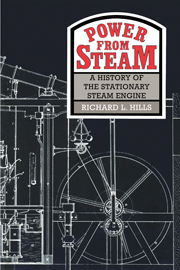Book contents
- Frontmatter
- Contents
- Preface
- Acknowledgements
- List of figures
- List of tables
- 1 The noblest machine
- 2 The impellent force of fire
- 3 Common old smoaking engines
- 4 The economy of power
- 5 The devil of rotations
- 6 Such unbounded power
- 7 Good servants but bad masters
- 8 An uncultivated field
- 9 The new theory of heat
- 10 The internal operation of the machine
- 11 Such absolute smoothness
- 12 Twinkle twinkle little arc
- 13 The drive for efficiency
- 14 An economical source of motive power
- 15 The most economical mode of obtaining power
- Notes
- Bibliography
- Index
10 - The internal operation of the machine
Improved valve gear and horizontal engines (1840–1880)
Published online by Cambridge University Press: 01 June 2011
- Frontmatter
- Contents
- Preface
- Acknowledgements
- List of figures
- List of tables
- 1 The noblest machine
- 2 The impellent force of fire
- 3 Common old smoaking engines
- 4 The economy of power
- 5 The devil of rotations
- 6 Such unbounded power
- 7 Good servants but bad masters
- 8 An uncultivated field
- 9 The new theory of heat
- 10 The internal operation of the machine
- 11 Such absolute smoothness
- 12 Twinkle twinkle little arc
- 13 The drive for efficiency
- 14 An economical source of motive power
- 15 The most economical mode of obtaining power
- Notes
- Bibliography
- Index
Summary
The increasing boiler pressures, the increasing speed of engines, the need for more accurate control of the speed and the development of compounding all meant that the older forms of valve gear became increasingly inadequate. Once it was seen that it was necessary to allow the steam to expand in the cylinder as much as possible, and therefore utilise the maximum range of heat, there was a gradual change from controlling the speed and power of the engine with the throttle valve to devising ways of allowing the steam to enter the cylinder at maximum pressure and then cutting off the entry of the steam at a suitable point to allow it to expand before the exhaust valve opened. The ideal valve should open quickly to allow the maximum amount of steam to enter the cylinder at maximum available pressure, e.g. full boiler pressure, for the precise period of time necessary to generate sufficient power to drive the engine and then it should close quickly, leaving the steam to expand until the end of the stroke. The exhaust valve too had to open quickly to allow the steam to pass to the condenser as quickly as possible, ideally at the same pressure as the condenser. The exhaust valve should remain open for the duration of the exhaust stroke to keep any back pressure low until it closed before the piston actually reached the end of the cylinder to create some compression to act as a cushion.
- Type
- Chapter
- Information
- Power from SteamA History of the Stationary Steam Engine, pp. 173 - 192Publisher: Cambridge University PressPrint publication year: 1989



